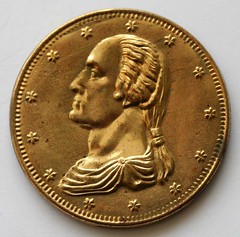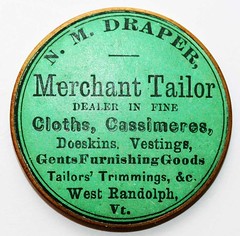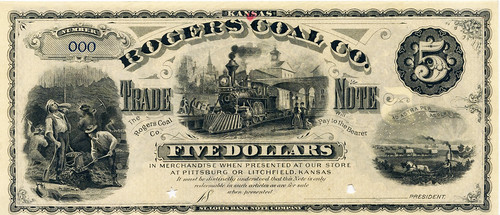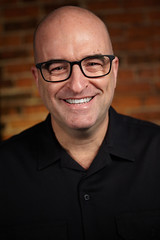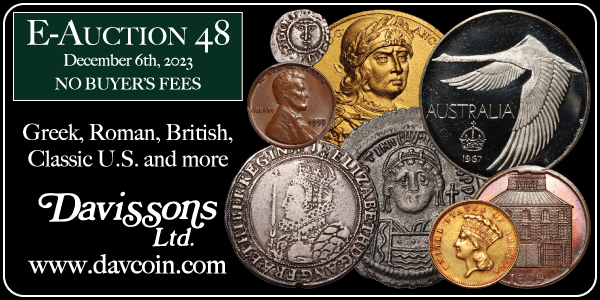
PREV ARTICLE
NEXT ARTICLE
FULL ISSUE
PREV FULL ISSUE
DAVID SCHENKMAN INTERVIEW, PART FOURGreg Bennick's latest interview for the Newman Numismatic Portal is with token expert David Schenkman. Here's the fourth of six parts, where Dave discusses underappreciated rarities. -Editor Greg Bennick: I just love the fact that these things spoke from history and spoke with history in the modern day. So, do you specialize, would you say, most in tokens and medals as I think you do, or is it also counterstamps? Is it also the Civil War tokens? I mean are you sort of a master and jack of all trades, as it were, or do you find yourself specializing in one of those areas?
One of these two types is the hard rubber token. Tokens were made of hard rubber, primarily from the Civil War years through the early 1880s. They were not struck, they were made in presses; it's kind of like a waffle iron type thing, and they hold up very well. And I cataloged those a number of years ago, and there's only a few hundred known ones. And every once in a while, an unlisted one pops up, but not very often. But these tokens are very under collected. And I think one of the reasons why is that you have to buy a book to know what you're doing with them. And so, people don't tend to want to spend the money for a book if they only have one or two of the tokens. The same thing holds true of embossed shell cards, and that's a series that was made from 1868 through the late 1870s for the most part. It consists of two pieces, generally embossed brass on one side with something resembling either a twenty dollar gold piece or a seated dollar, and the other side would have an advertisement of a merchant. And these were usually a little bigger than a half dollar and smaller than a silver dollar. Dave Bowers, a few years ago, wrote a fascinating book about these tokens, a catalog of them giving a lot of historical information. The thing that I find so interesting about these tokens from the standpoint of collecting them is that they sell for a fraction of what civil war tokens of the same rarity sell for.Greg Bennick: Why do you think that is? David Schenkman: Well Civil War tokens have been collected for a lot longer. There's an organization of civil war token collectors, and there have been catalogs out for a long time. Greg Bennick: So, it gives people a frame of reference, much like I was saying before, that if a variety becomes Red Book official, all of a sudden it's collectible. Whereas beforehand maybe perhaps not. David Schenkman: True, Civil War tokens can bring huge money. And the ones that a lot of times bring the highest prices are the ones that really aren't legitimate, they were made for collectors. But you know, to each his own. I find it interesting that Civil War tokens will invariably bring a lot more money than political tokens with, say, Lincoln campaign tokens, which are generally rarer, but they're not as collected. Greg Bennick: There's only a small number of people who collect something. Even if there's only 15 of them, then there are more than the number of collectors who want them. If there's only five collectors who want them, that means there's three per collector and all of a sudden the desirability goes down in a way. So hopefully there'll be more collectors of these hard rubber tokens. And what was the other, encased store cards? David Schenkman: Embossed shell cards. If you happen to pick up a copy of that book, the Token Metal Society published it, that you'll find it fascinating because it's a lot of information and there are historical information for the pieces. Dave Bowers, of course, does a wonderful job with series like that. A number of years ago I published several books on tokens myself, and I published the Hard Rubber Token book myself. I published it knowing that I was going to lose money with it because it was an expensive book and cost a lot to do, but I didn't care, I just wanted to do it.
Greg Bennick: That makes sense. Now is the book US Shell Cards 1867 to 1880? Is that the book we're talking about? David Schenkman: Yeah, I think so, yes. Greg Bennick: Yeah, I just looked it up. So that looks definitely interesting. I personally love buying books even on things that I don't know anything about, just because it is always fun to pull something off the shelf and then learn about something brand new. I want to make sure before I forget to let people know that the Token and Medal society, if you look up tokenandmetal.org, you're going to find information on the Token and Medal society. And then also I just want to make sure to put in a good word for the Civil War token society. People can simply Google them. I think it's CWTS society. I have to do a double check just to make sure, I don't want to give the wrong reference, but the Civil War Token Society and Token and Metal Society, great places to start to learn about these endless frontiers essentially of areas of numismatics which aren't as popular perhaps as Lincoln cents and Morgan dollars certainly. Not to disparage Lincoln cent and Morgan dollar collectors because there's lots of them, and they're fun too. But these are definitely areas that are fringe in a way when you take the whole spectrum of popular numismatics to consideration. David Schenkman: That's very true. And by the way, it is CWTSociety.com . Greg Bennick: There we go, perfect. Thank you. David Schenkman: And they publish the quarterly magazine that's excellent also. And recently I persuaded them to change the name of the magazine from the Civil War Token Journal I believe it was to Civil War Era Numismatics and my feeling was that opening it up to articles other than strictly Civil War tokens, so people can write articles now and have them published. - for instance - I wrote an article on Grand Army of the Republic Encampment medals, which are all post-Civil War, but there were organizations that Civil War veterans joined. And so things like political tokens and other types of tokens other than strictly Civil War tokens are now included. So they've been around for a long time also. And again, it's well worth the nominal dues. Greg Bennick: It's great. And one thing I do want to throw out there as well to listeners is that joining an organization is important and great. Contributing to an organization really deepens the experience. And I know that when I started writing for Errorscope about error coins, for example, I started to get feedback and it was fun. And you start to build friendships and connections and community. So, I'd suggest if someone was to join, for example, Token and Medal Society or The Civil War Token Society, consider writing an article even as a beginner. Consider writing an article and submit it and then get some advice on writing and contributing because, the more one contributes, the hobby grows, of course, but also it's more fun. You start to build community that way, and I'm sure that you've found that to be true. You've been writing articles for organizations and for magazines across the board for decades at this point. David Schenkman: A lot of decades, I guess! (laughter) And the Token and Medal Society magazine, we have an editor now, Greg Burns, who does a wonderful job, and he will assist anybody. If a person's not confident of their ability to write an article, he will help and I would help anybody that was interested in doing something like that. I think there are a lot of other people that would help also. So, it's a smaller society than the coin collecting society and people tend to know each other more. Greg Bennick: I hope that all this comes across as encouragement for either new collectors or seasoned collectors to get even more involved. I think that the stronger our connections are to one another, the more fun ultimately that we all have. So I wanted to ask you a couple of things. You know, you taught at summer seminar, the ANA summer seminar for many years. I was going to ask, what did you teach at the ANA summer seminar? David Schenkman: I taught a class in US tokens and I taught for 18 years and most of the years was that. But I taught several years on the subject of Civil War era numismatics and I had co-instructors with that. I did tokens, medals, badges, things of that sort. And Wendell Wolka, who is a paper money specialist, did paper money, and we did that for a few years. I had a lot of fun with it. That's a wonderful place to go for the summer. And people tend to come back year after year, which says that they're enjoying it. Whether you're collecting tokens, medals or numismatic literature, there are courses in that every year. They still have it. I don't know if they have a token course or a Civil War course anymore, but they might. And if you get knowledgeable enough you could teach one. They were always looking for knowledgeable instructors. I think that when you get involved with things like tokens and medals, you tend to find things to keep branching out to. One thing leads into another. For instance, I started collecting coal mine tokens issued by the coal mines, scrip, in the sixties. And I still do, but eventually I branched out to collecting obsolete paper money issued by coal mines, which is quite a bit rarer in many cases because paper being fragile. And I just finished a book which hopefully will get published this year, a catalog of paper coal mine notes from the 19th century. Greg Bennick: Well, since you brought it up, tell us a little bit about these coal mining tokens. What were they? Were they for use say, in a company store, that sort of thing. And then the obsolete paper money connected to the coal mines as well. Tell us about that as well.
David Schenkman: Well, there's a song:
David Schenkman: Yes. And that pretty well describes them. Coal mines were generally in
pretty isolated areas, and in many cases, the coal company owned virtually the whole town.
They built the town around the mines and they would build inexpensive homes for the miners,
which they would rent to them and they would build churches. And of course, they built stores
that the company owned, and they sold pretty much anything you might want, housing items,
you name it, at prices that often were quite a bit higher than they might be at another store. Coal
miners generally were paid every two weeks, and when you started working, the first pay was
withheld. So by the time a miner got paid, he might have run out of money before then and need
to borrow from the company. And the way the loans would be made would be in scrip, which
would be only spendable at the company store. So, the tokens would have the name of the coal
mine on them and the other side would say Greg Bennick: Wow. So basically, the company would own not just the work time of the worker, but basically the life and commerce and everything of the worker. It would be this all inclusive experience. I shouldn't even say all inclusive. It makes it sound like working in a coal mine was a resort in the Bahamas, but it's more that it was an all-consuming in a sense experience where the workers didn't need to do anything beyond the coal mine and its store and its world, essentially. That's pretty fascinating. I had no idea. David Schenkman: Well, in the late 19th century and early first part of the 20th century, they couldn't do anything because these mines were generally in fairly isolated areas. The roads weren't good. Most of the miners couldn't afford to buy cars, so they had no alternative. they pretty much had to buy at the company store. So, there's been records of mines that have actually, in some cases, made more money with their stores than they did from the mines. Greg Bennick: Specifically, coal mines? Were gold mines or silver mines included as well out west? David Schenkman: Yes, to a much lesser extent. To give you an idea of the scope of this, there's two volumes of the coal mine token catalog. And between the two volumes, I think there's probably well over 15,000 varieties listed. Now, bear in mind that some companies issued maybe they see 10, 15 different varieties and denominations, but still, that's a lot of tokens. Greg Bennick: Yeah, I mean, endless. And like you said, you're never going to be able to collect them all essentially. You're going to be always on the search and maybe finding new things. But the idea of finding 15,000, there's probably very few people who would have the wherewithal, the luck, the fortune to be able to do that. Even if those 15,000 items were collectible, maybe there's only one of each. As you mentioned, some of these things might be quite rare. David Schenkman: Some of them are very rare.
To watch the complete video, see:
To read the complete transcript, see:
To read the earlier E-Sylum articles, see:
Wayne Homren, Editor The Numismatic Bibliomania Society is a non-profit organization promoting numismatic literature. See our web site at coinbooks.org. To submit items for publication in The E-Sylum, write to the Editor at this address: whomren@gmail.com To subscribe go to: https://my.binhost.com/lists/listinfo/esylum All Rights Reserved. NBS Home Page Contact the NBS webmaster 
|

